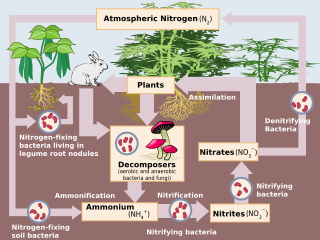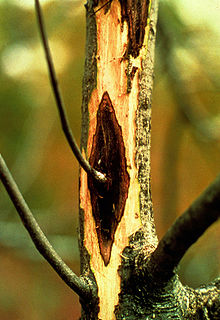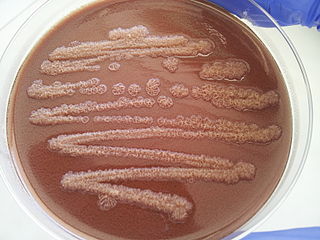
Denitrification is a microbially facilitated process where nitrate (NO3−) is reduced and ultimately produces molecular nitrogen (N2) through a series of intermediate gaseous nitrogen oxide products. Facultative anaerobic bacteria perform denitrification as a type of respiration that reduces oxidized forms of nitrogen in response to the oxidation of an electron donor such as organic matter. The preferred nitrogen electron acceptors in order of most to least thermodynamically favorable include nitrate (NO3−), nitrite (NO2−), nitric oxide (NO), nitrous oxide (N2O) finally resulting in the production of dinitrogen (N2) completing the nitrogen cycle. Denitrifying microbes require a very low oxygen concentration of less than 10%, as well as organic C for energy. Since denitrification can remove NO3−, reducing its leaching to groundwater, it can be strategically used to treat sewage or animal residues of high nitrogen content. Denitrification can leak N2O, which is an ozone-depleting substance and a greenhouse gas that can have a considerable influence on global warming.

A plant canker is a small area of dead tissue, which grows slowly, often over years. Some cankers are of only minor consequence, but others are ultimately lethal and therefore of major economic importance in agriculture and horticulture. Their causes include such a wide range of organisms as fungi, bacteria, mycoplasmas and viruses. The majority of canker-causing organisms are bound to a unique host species or genus, but a few will attack other plants. Weather and animals can spread canker, thereby endangering areas that have only slight amount of canker.

The Pseudomonadales are an order of Proteobacteria. A few members are opportunistic pathogens, such as species of Pseudomonas, Moraxella, and Acinetobacter, which may cause pneumonia.
Denitrifying bacteria are a diverse group of bacteria that encompass many different phyla. This group of bacteria, together with denitrifying fungi and archaea, is capable of performing denitrification as part of the nitrogen cycle. Denitrification is performed by a variety of denitrifying bacteria that are widely distributed in soils and sediments and that utilize oxidized nitrogen compounds in absence of oxygen as a terminal electron acceptor. They metabolise nitrogenous compounds using various enzymes, turning nitrogen oxides back to nitrogen gas or nitrous oxide.
Pseudomonas pachastrellae is a Gram-negative bacterium found in deep-sea sponges. The type strain is JCM 12285.
Pseudomonas xanthomarina is a bacterium found in marine ascidians. Unlike many other members of the genus Pseudomonas, it is not fluorescent.
Pseudomonas coenobios is a Gram-negative, non-sporulating, motile, rod marine bacterium. The type strain is ATCC 14402.
Pseudomonas balearica is a Gram-negative, rod-shaped, nonfluorescent, motile, and denitrifying bacterium. It is an environmental bacterium that has been mostly isolated from polluted environments all over the world. Many of the isolates have demonstrated capabilities to degrade several compounds. Some of the strains are naphthalene degraders and one strain isolated in New Zealand has demonstrated the potential to oxidize inorganic sulfur compounds to tetrathionate. Based on 16S rRNA analysis, P. balearica has been placed in the P. stutzeri group.

Pseudomonas stutzeri is a Gram-negative soil bacterium that is motile, has a single polar flagellum, and is classified as bacillus, or rod-shaped. While this bacterium was first isolated from human spinal fluid, it has since been found in many different environments due to its various characteristics and metabolic capabilities. P. stutzeri is an opportunistic pathogen in clinical settings, although infections are rare. Based on 16S rRNA analysis, this bacterium has been placed in the P. stutzeri group, to which it lends its name.
In enzymology, a 4-hydroxybenzoyl-CoA reductase (EC 1.3.7.9) is an enzyme found in some bacteria and archaea that catalyzes the chemical reaction
In enzymology, a 3-hydroxycyclohexanone dehydrogenase is an enzyme that catalyzes the chemical reaction
In enzymology, a 4-hydroxybenzaldehyde dehydrogenase (EC 1.2.1.64) is an enzyme that catalyzes the chemical reaction

A bacillus, or bacilliform bacterium, is a rod-shaped bacterium or archaeon. Bacilli are found in many different taxonomic groups of bacteria. However, the name Bacillus, capitalized and italicized, refers to a specific genus of bacteria. The name Bacilli, capitalized but not italicized, can also refer to a less specific taxonomic group of bacteria that includes two orders, one of which contains the genus Bacillus. When the word is formatted with lowercase and not italicized, 'bacillus', it will most likely be referring to shape and not to the genus at all. Bacilliform bacteria are also often simply called rods when the bacteriologic context is clear.
Aerobic denitrification or co-respiration the simultaneous use of both oxygen (O2) and nitrate (NO3−) as oxidizing agents, performed by various genera of microorganisms. This process differs from anaerobic denitrification not only in its insensitivity to the presence of oxygen, but also in that it has a higher potential to create the harmful byproduct nitrous oxide.
Nitric oxide reductase (cytochrome c) (EC 1.7.2.5) is an enzyme with systematic name nitrous oxide:ferricytochrome-c oxidoreductase. This enzyme catalyses the following chemical reaction
Advenella faeciporci is a nitrite-denitrifying bacterium from the genus Advenella which was isolated from piggery wastewater.
Nocardioides daejeonensis is a gram-positive, denitrifying, rod-shaped, aerobic and non-motile bacterium from the genus Nocardioides that has been isolated from a sewage disposal plant at Daejeon, South Korea.
Bowmanella denitrificans is a Gram-negative, heterotrophic and denitrifying bacterium from the genus of Bowmanella which has been isolated from shallow coastal water from the An-Ping Harbour in Tainan in Taiwan.
Noviherbaspirillum autotrophicum is a Gram-negative and rod-shaped bacterium from the genus of Noviherbaspirillum which has been isolated from rice paddy soil.

Phenylacetyl-CoA (C29H42N7O17P3S) is a form of acetyl-CoA formed from the condensation of the thiol group from Coenzyme A with the carboxyl group of phenylacetic acid.





